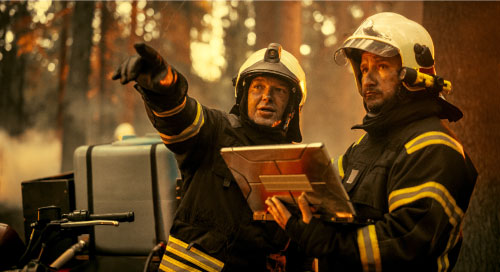Mobile Edge Servers Empower First Responders

First responders face a uniquely challenging edge environment. The nature of their work—such as fighting fires or handling medical emergencies—requires equipment with unquestionable reliability. But the unpredictability of their environments makes robust connectivity anything but guaranteed. Emergencies can arise anywhere, and each location has its own mix of communication technologies.
“They may have to stitch a variety of networks together, usually radio networks,” explains Chris Ericksen, Chief Revenue Officer at Klas, a provider of rugged technology. “They can’t assume that they’re going to have radio spectrum, Wi-Fi, or any other particular capabilities.”
This unreliable network environment impedes efforts of firefighters, paramedics, and other first responders to create coordinated, data-driven responses for society’s needs. “A top priority in any emergency is understanding the state of play,” says Ericksen. “First responders need a real-time map of data assets in the area, video feeds from those assets, and an analysis of that video overlaid on old records to see the differences. If they’re in a space where data might not be in the same language, they need to translate that data on the fly.”
To accomplish these tasks without a reliable high-speed backhaul, first responders need enterprise-grade computing at the mobile edge. To meet these demands, Klas has brought its experience in defense applications to the first-responder sector.
“First responders are becoming more like defense operations,” notes Ericksen. “They need to make decisions with the best data possible, even with limited connectivity.”
Defense-Grade Communications at the Mobile Edge
Its latest offering, VoyagerVM 4.0 is a portable server designed to provide enterprise-grade computational power, data throughput, and storage at the edge.
“Historically, there was a clear distinction between the headquarters and the edge. The farther first responders got from headquarters, the more capabilities they would lose,” says Ericksen. “Our goal is ubiquitous infrastructure, with the same capabilities everywhere,” including machine learning and artificial intelligence.
To achieve this ambitious aim, VoyagerVM 4.0 brings together the latest Intel® Xeon® D processor, up to 100 Gbps in aggregate throughput, and up to four NVMe devices for high-speed storage. These technologies combine to create a platform that delivers impressive levels of computing and networking in edge environments.
“#FirstResponders are becoming more like #defense operations. They need to make decisions with the best data possible, even with limited #connectivity” – Chris Ericksen, @klasgroup via @insightdottech
Although these capabilities of VoyagerVM 4.0 resemble those of a traditional server, its physical design is remarkably different. Compared to a 19” rack server, VoyagerVM 4.0 is significantly smaller, measuring just 7.4” (188 mm) wide. The server is also remarkably sturdy. It is designed to military standards, enabling it to withstand drop, shock, and vibration with no degradation in operational performance.
This compact, rugged design makes the server well-suited to first-responder use cases. It can fit into ambulances, mobile command centers, and other cramped vehicles. It can handle bumpy rides and temperature fluctuations from -26 °F to 122 °F (-32 °C to 50 °C). And it keeps the power load on the vehicle to a minimum, drawing only 110 W.
These advantages flow directly from the capabilities of the Intel Xeon D processor, which features a low-power, heat-tolerant design optimized for the rugged edge.
Security at the Forefront
To keep first responders safe, digital security is paramount. As Ericksen explains, “Intel continues to excel from a security perspective,” noting that Klas leverages Intel technologies for secure boot, data encryption, and secure software enclaves.
Klas has also developed its own technologies to enhance security. For example, the company developed its own version of OpenBMC, an open-source project for hardware management. This specialized firmware monitors the physical state of a computer and communicates with the system administrator through an independent connection. And since Klas created its own version, they can rapidly manage any vulnerabilities associated with it.
These same technologies help streamline system deployment and management. The company has developed a software platform for automation named Blackrock, which leverages the security features of Intel Xeon D processors and is closely integrated with OpenBMC. Among other benefits, Blackrock enables quick and efficient provisioning of servers for deployment in the field.
The end goal is to help first responders focus on people, not tech. “First responders are not IT people, they just use tech to do their job,” observes Ericksen. “So we need to make it as easy as possible.”
Data-Driven Decisions at the Mobile Edge
With technology like VoyagerVM 4.0, first responders gain critical insights for better decision-making in emergencies.
The design of the solution demonstrates the importance of helping responders concentrate on their primary goal: saving lives and safeguarding communities. Thus, AI and other applications newly enabled by rugged edge servers signify not just a technological leap but a pivotal enhancement in how first responders can perform their duties more efficiently and safely, and directly benefit communities in times of need, Ericksen explains.
This article was edited by Christina Cardoza, Editorial Director for insight.tech.